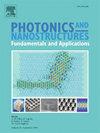连续介质中准束缚态控制的WS2超表面偏振灵敏度工程
IF 2.5
3区 物理与天体物理
Q3 MATERIALS SCIENCE, MULTIDISCIPLINARY
Photonics and Nanostructures-Fundamentals and Applications
Pub Date : 2025-04-22
DOI:10.1016/j.photonics.2025.101387
引用次数: 0
摘要
连续介质中的束缚态(bic)具有显著的潜力,可以增强具有高质量(Q)因子共振的光-物质相互作用。同时,二硫化钨(WS2),一种过渡金属二硫化物(TMDC),提供了一种实现强耦合的途径,引起了研究人员的极大兴趣。在这项研究中,我们采用两种不同的方法,设计了由大块WS2板构成的超表面的偏振灵敏度。首先,我们合成了一个由不同尺寸的双平板组成的偏振敏感超表面,以实现对称保护bic。入射波电场方向的旋转导致透射率响应的剧烈变化。相反,通过考虑四板单元电池,我们开发了一种与极化无关的超表面,该超表面对入射波的电场的任何方向都有独特的响应。对于这两种类型的超表面,我们展示了通过调整不对称程度来产生和调谐准bic共振。此外,我们阐明了如何通过缩放单元胞的平面内尺寸来实现以反交叉图案为特征的强耦合状态。在强耦合条件下,极化敏感和非极化超表面的Rabi分裂值分别为104.2 meV和116.8 meV。本文提出的偏振灵敏度工程可以应用于各种光子系统,从而开发出高灵敏度或偏振无关的器件。本文章由计算机程序翻译,如有差异,请以英文原文为准。
Polarization sensitivity engineering in WS2 metasurfaces governed by quasi-bound states in the continuum
Bound states in the continuum (BICs) hold significant potential for enhancing light-matter interactions with high quality (Q) factor resonances. Concurrently, tungsten disulfide (WS2), a transition metal dichalcogenide (TMDC), provides a pathway to attain the strong-coupling regime, garnering significant interest from researchers. In this study, we engineer polarization sensitivity in metasurfaces constructed from bulk WS2 slabs, employing two distinct approaches. Firstly, we synthesize a polarization-sensitive metasurface composed of dual slabs with varying dimensions to achieve symmetry-protected BICs. The rotation of the electric field direction of the incident wave leads to a dramatic change in the transmittance response. Conversely, by considering a quad-slab unit cell, we develop a polarization-independent metasurface that exhibits a unique response to any orientation of the electric field of the incident wave. For both types of metasurfaces, we demonstrate the generation and tuning of quasi-BIC resonances by adjusting the degree of asymmetry. Furthermore, we elucidate how to achieve the strong coupling regime characterized by an anticrossing pattern through scaling the in-plane dimensions of the unit cell. In the strong coupling regime, Rabi splitting exhibits two distinct values of 104.2 meV and 116.8 meV for polarization-sensitive and polarization-independent metasurfaces, respectively. The polarization sensitivity engineering presented herein can be applied across various photonic systems, enabling the development of devices that are either highly sensitive or polarization-independent.
求助全文
通过发布文献求助,成功后即可免费获取论文全文。
去求助
来源期刊
CiteScore
5.00
自引率
3.70%
发文量
77
审稿时长
62 days
期刊介绍:
This journal establishes a dedicated channel for physicists, material scientists, chemists, engineers and computer scientists who are interested in photonics and nanostructures, and especially in research related to photonic crystals, photonic band gaps and metamaterials. The Journal sheds light on the latest developments in this growing field of science that will see the emergence of faster telecommunications and ultimately computers that use light instead of electrons to connect components.

 求助内容:
求助内容: 应助结果提醒方式:
应助结果提醒方式:


